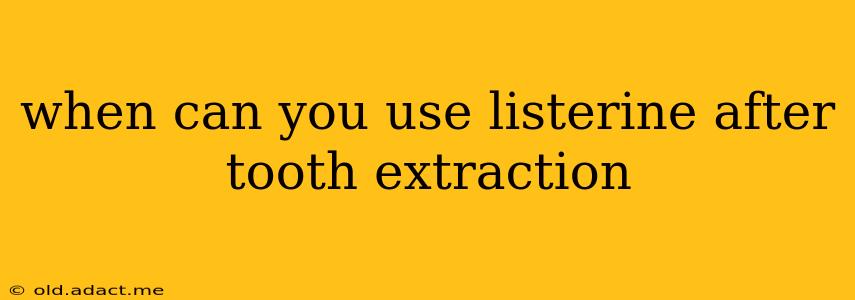When Can You Use Listerine After Tooth Extraction?
The question of when you can use Listerine after a tooth extraction is a common one, and the answer is nuanced. While Listerine is a popular mouthwash known for its antiseptic properties, using it too soon after an extraction can be detrimental to the healing process. This post will delve into the specifics, addressing common concerns and providing clear guidance.
Understanding the Healing Process After Tooth Extraction
After a tooth extraction, a blood clot forms in the socket where the tooth was removed. This blood clot is crucial for healing; it protects the bone and nerve endings, preventing infection and pain. The healing process involves the gradual formation of new tissue to fill the socket. Disrupting this delicate process can lead to complications like dry socket (alveolar osteitis), a painful condition where the blood clot is dislodged.
So, When Can You Use Listerine?
The general recommendation is to avoid using Listerine or any other mouthwash for at least 24 hours after a tooth extraction. This allows the blood clot to form properly and begin the healing process.
Why the Wait?
The active ingredients in Listerine, such as alcohol and essential oils, can:
- Irritate the extraction site: The delicate tissues in the extraction socket are highly sensitive post-surgery. Listerine's strong ingredients can further irritate this area, potentially delaying healing and causing discomfort.
- Dislodge the blood clot: The forceful rinsing action associated with using mouthwash can dislodge the crucial blood clot, increasing the risk of dry socket.
- Interfere with healing: Some studies suggest that the antibacterial properties of certain mouthwashes might even interfere with the body's natural healing processes.
What to Use Instead of Listerine Immediately After Extraction?
For the first 24 hours, focus on gentle rinsing with salt water. Dissolve 1/4 to 1/2 teaspoon of salt in 8 ounces of warm water and gently swish it around your mouth, avoiding the extraction site directly. This helps keep the area clean without disturbing the blood clot.
How Soon Can I Use Listerine After Salt Water Rinses?
After the initial 24-hour period of salt water rinsing, you can gradually reintroduce a mild mouthwash like Listerine, but with caution:
- Dilute it: Consider diluting the Listerine with an equal amount of water to reduce its potency.
- Gentle rinsing: Avoid forceful rinsing. Gently swish the diluted mouthwash around your mouth, avoiding the extraction site.
- Observe for any irritation: If you experience any burning, stinging, or increased discomfort, discontinue use immediately and revert to salt water rinses.
- Consult your dentist: It's always best to check with your dentist or oral surgeon for personalized advice on when and how to use mouthwash after your specific extraction.
Can I Use Listerine If I Have Dry Socket?
No. If you suspect you have dry socket (severe pain, bad breath, and a visible empty socket), do not use Listerine. Contact your dentist immediately. They will provide appropriate treatment to manage the condition.
What are the Long-Term Benefits of Using Mouthwash After Tooth Extraction (Once Healing is Complete)?
Once your extraction site is fully healed (typically several weeks), using mouthwash like Listerine can help maintain good oral hygiene. It can assist in preventing infection and keeping your mouth fresh. However, remember to use it as directed and consult your dentist if you have concerns.
In Conclusion:
Patience and careful oral hygiene are key to successful healing after a tooth extraction. While Listerine can be beneficial for oral health in the long run, it's crucial to wait at least 24 hours post-extraction before using it, and then only with caution and under the guidance of your dentist. Prioritizing gentle salt water rinses initially is crucial for minimizing the risk of complications. Always consult with your dental professional for personalized advice tailored to your specific situation.
